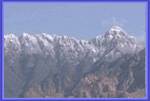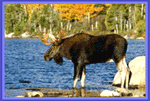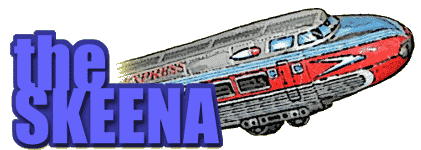 |
 |
 |
|
|||
|
The Skeena Edna St. Vincent Millay once wrote that "there isn't a train I wouldn't take, no matter where it's going", and I agree. When my family planned a vacation to the Canadian Rockies, there was no question that a train ride would be part of the agenda. My research showed that one of the least expensive and most scenic options was a train called the Skeena, a tiny four-car local that runs three days a week between Jasper, Alberta, and Prince Rupert, on the Pacific Coast. The Skeena has the reputation of being something of a backwoods commuter line. I couldn't resist. Jo Jo Johnson is one of the train attendants I met on the Skeena. 
Johnson: "It's the closest, uh, any train in Canada comes to a glacier. We see Indian pictographs, which are over two-hundred years old and, uh, lots of waterfalls along that leg of the journey, when we hit the Coastal Mountains. And, generally, I'd say, it's just, uh, one of the last true wilderness, uh, areas of North America." Shortly after we left Jasper, the Skeena climbed over Yellow Head Pass. There were icy peaks to the left and right, but one mountain was mysteriously enshrouded in clouds. Marielle Lebeuf, another train attendant, told us:
Lebeuf: "This is Mt. Robson. And, Mt. Robson is 12,972 feets high. And the highest mountain in the Rockies Mountains, this part." For the next several hundred miles, we ran along the Fraser River, through backwoods country. There were very few towns. Sometimes, we'd just pass a single house with an enormous satellite dish. Jo Jo Johnson told me that many of the towns on the Skeena's route have no road access and rely on the train as their sole means of transportation. One of the tiniest is Penny. It's the only town in Canada that still receives its mail from the train.
Johnson: "It has a population of ten people, so there's a little tiny post office there; it's the cutest post office you'll ever see. There's a house there where a couple once lived. They used to come out and they would wave at the train every single day and greet us. And since they've departed, they've painted their silhouettes on the side of the house, so they are eternally waving!" The Skeena will stop anywhere along the line, to pick up riders. One regular passenger literally walks out of the woods every few months to flag the train down for a supply run.
Johnson: "Andrew lives about three miles away from the track, kind of in the middle of nowhere. But, when he goes for supplies, he brings about, I don't know, thirty or forty boxes with him. So you load 'em on, then we unload 'em when we hit, uh, whatever mile it is where he gets off. But, we always bug him, we say "well, how are you gonna get all these supplies home?" And he says, "well," he says, "I've got three months to do it," so, I guess he just walks back and forth or something. One coach is set aside for regular passengers, while two coaches accommodate travelers in first class, or "Totem Class," as it's called on the Skeena. That's where I was sitting. The passengers in Totem Class were a lively bunch. On the second day, I heard a group of people singing a Mozart aria in English accents and I went to investigate. 
Lady from Wimbledon: "What you have just heard is a very early rehearsal, for- for, uh, a little musical interlude at my son's wedding in Seattle." One of the reasons I rode in Totem Class was to have access to the Park Car, with its lovingly restored vista-dome. It gave me a 360 degree view of the scenery and the wildlife, as well. I saw deer, a bald eagle, several leaping salmon and a whale, near the port of Prince Rupert. But, no bears, alas. Jo Jo Johnson says that bear watching from the train can be amusing.
Johnson: "Throughout here, there's a lot of, uh, grain trains that run. And, uh, there's the odd derailment, of course, of these grain trains. So, when the cars fall over, uh, they leave the grain there and it sometimes ferments. So, these bears'll come along and eat the fermented grain and they're drunk bears, I guess! Uh, they're lots of fun, 'cause they'll stand on their back legs, sometimes they'll be falling over and just- Oh, yeah, it's a lot of fun to see." Do you know the bumper sticker that says "I brake for animals?" Well, Skeena engineer Anita Marple says one winter she had to brake for a moose!
Marple: "It was a heavy snow year. There was probably ten feet of snow on the right of way, both sides, and the moose was on the track. We had to follow this moose for twenty miles and I'm standing on the front of the engine with a broom, hitting him in the butt, eh? The Skeena runs year-round, though Totem Class is available only from mid-May to October. After that, the train cuts back to two cars and continues its long distance commuter duties. For the Savvy Traveler, I'm Jeff Lunden.
|
 | American Public Media Home | Search | How to Listen ©2004 American Public Media | Terms of Use | Privacy Policy |

